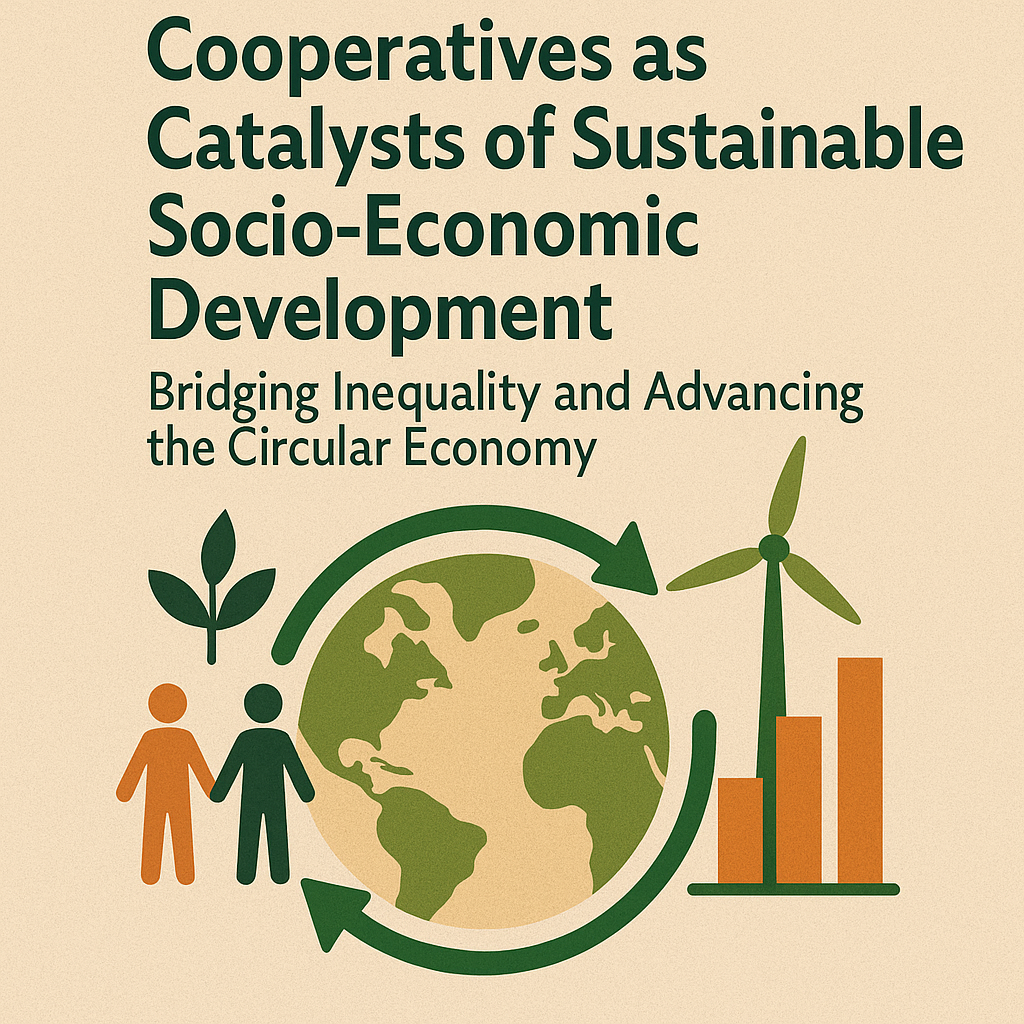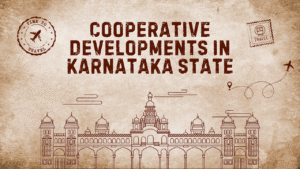Cooperatives as Catalysts of Sustainable Socio-Economic Development: Bridging Inequality and Advancing the Circular Economy
Jyoti Saroop, Director, The Unati Agri Allied and Marketing Multistate Cooperative
Society Ltd. Talwara, Distt. Hoshiarpur Punjab, India-144216
Abstract
Cooperatives—numbering over three million worldwide—represent a significant institutional
force, engaging one in eight individuals globally and underpinning the livelihoods of nearly 280 million people, constituting close to 10% of the global labour force. Their unique
structure, grounded in democratic ownership and participatory governance, positions them at the confluence of economic equity, social inclusion, and environmental sustainability. This multidimensional alignment has been recognised through the United Nations General Assembly Resolution 78/175, which also declared 2025 the International Year of Cooperatives. Synthesising data from the UN, FAO, and the International Cooperative
Alliance (ICA), this article explores the transformative potential of cooperatives in addressing value asymmetries in agri-food systems, embedding circular economy (CE) principles, and catalysing policy innovation in India post-2021. The paper briefly illustrates this through a small-scale cooperative-led intervention before concluding with key research
and policy priorities essential for scaling cooperative pathways towards inclusive and sustainable development.
Keywords: Cooperatives · Circular Economy · Sustainable Development · India · Inclusive Growth · Democratic Governance · Policy Innovation
1. Introduction
While global economic integration has generated considerable wealth, its benefits have been unevenly distributed, reinforcing structural inequalities and accelerating ecological degradation. In the agri-food sector, these disparities are acutely visible: smallholder producers face stagnating or declining real incomes, even as food prices for consumers
reach historic highs. The structural inefficiency of intermediary-dominated value chains, coupled with inadequate institutional safeguards, has exacerbated rural–urban divides and
undermined livelihood resilience.
In this context, cooperatives have re-emerged as vital institutional correctives—
organisations capable of redistributing value more equitably, empowering marginalised groups, and facilitating sustainable transitions. As locally rooted, democratically governed
entities, cooperatives embody a hybrid logic of economic functionality and social solidarity. Global policy momentum now reflects this recognition. The United Nations’ recent resolution and India’s creation of a dedicated Ministry of Cooperation underscore a renewed global and national prioritisation of cooperatives as agents of systemic change.
2. The Multidimensional Value of Cooperatives
The economic scale of the global cooperative sector is both impressive and understated. According to the World Cooperative Monitor (2023), the top 300 cooperatives generate a combined turnover of USD 2.4 trillion, spanning agriculture, insurance, and retail. However, their significance lies not only in size but in structural value creation across four critical
dimensions: First, cooperatives redistribute economic surplus through mechanisms like patronage dividends, local reinvestment, and shared asset ownership. This creates endogenous growth loops that reduce capital leakage and increase local economic density.
Second, social inclusion is advanced through proportional representation, gender-specific initiatives, and community-driven leadership models. Cooperative governance structures inherently accommodate pluralistic participation, facilitating greater civic and economic agency among historically excluded groups.
Third, cooperatives exhibit pronounced resilience during systemic shocks. Their reliance on member capitalisation, embedded community networks, and mission-driven operations enhances their ability to maintain service continuity and employment during economic downturns or ecological disruptions.
Fourth, environmental responsibility is increasingly institutionalised within cooperative frameworks. Driven by a stakeholder logic rather than shareholder primacy, cooperatives are integrating CE principles—prioritising waste reduction, decentralised processing, and renewable energy integration.
Empirical studies further reinforce this claim. In Italy, Kenya, and South Korea, cooperative utilities have achieved 15–30% lower lifecycle emissions compared to investor-owned firms, suggesting superior environmental performance aligned with CE transitions.
3. India’s Cooperative Turn: Structural Reform and Strategic Reorientation
India’s cooperative landscape—comprising over 8.5 lakh registered societies—has historically been fragmented, operating without a unified policy vision. The 2021 formation
of the Ministry of Cooperation marked a paradigmatic shift, bringing strategic coherence to the sector. The national campaign “Sahakar se Samriddhi” (Prosperity through Cooperation)
reflects an ideological repositioning: from state-subsidised rural development to enterprise led cooperative governance.
Under this framework, several policy instruments have been mobilised. The digitisation of Primary Agricultural Credit Societies (PACS) enhances operational transparency and data interoperability. Simultaneously, access to long-term capital has been expanded through the National Cooperative Development Corporation (NCDC), fostering enterprise viability
beyond subsistence scales. Youth and women-led initiatives—through schemes like Yuva Sahakar and Nandini Sahakar—signal an intent to democratise opportunity and leadership
within the cooperative ecosystem. In addition, CE-aligned interventions are gaining traction. By establishing processing and storage facilities proximate to production zones, cooperatives are reducing post-harvest
losses, curbing emissions from logistics chains, and creating nodes of local value addition.
4. Cooperatives and the Architecture of the Circular Economy
The transition to a circular economy necessitates governance architectures that enable equitable resource allocation, long-term stewardship, and regenerative value creation.
Cooperatives, by virtue of their institutional DNA, offer three structural advantages particularly conducive to CE transitions.
First, their member-centric governance prioritises intergenerational sustainability over
quarterly profitability, enabling investments in infrastructure such as composting units,
biogas plants, and closed-loop processing systems.
Second, cooperatives embody multi-stakeholder ownership models, integrating producers,
consumers, and workers into a common governance structure. This facilitates shared
responsibility in value chain decision-making and fosters mutual accountability.
Third, by retaining surplus locally, cooperatives enhance the economic viability of
community-level CE infrastructure—such as solar microgrids, shared logistics, and waste
to-resource hubs.
Quantitative evidence supports this alignment. In Italy, cooperative agri-food districts report
Material Circularity Index (MCI) scores 20% above regional averages. In Spain, the
Mondragón network has operationalised reverse logistics and modular production systems
that significantly reduce resource throughput and material waste.
Within the Indian context, early-stage innovations reflect this trend. For instance, a Unati
Agri Allied and Marketing Multistate Cooperative operating in North India has implemented
a decentralised “farm-to-factory-to-fork” model. By leveraging women-led distribution
networks and local processing units, it has reduced post-harvest loss by 12% and increased
household incomes. Though small in scale, such initiatives demonstrate the viability of CE
aligned cooperative ecosystems and offer scalable templates for replication.
5. Research Gaps and Policy Imperatives
Despite the growing relevance of cooperatives, several analytical and operational gaps
remain. Longitudinal data are needed to assess the distributional impacts of cooperative
participation across landholding classes and socio-economic strata. Similarly, gender
sensitive evaluations must go beyond participation metrics to examine outcomes related to
income, agency, and leadership.
From a CE perspective, standardised metrics—such as carbon intensity per unit of output
and sector-specific circularity indices—should be embedded into cooperative audit
frameworks. This would enable comparability, traceability, and performance-based policy
incentives.
Policy design should also evolve to reflect cooperative specificities. Blended finance
instruments must be adapted to align with cooperative equity norms and risk appetites.
Open-source digital platforms, co-created with sector stakeholders, can enhance inter
cooperative knowledge transfer, real-time tracking, and federated data ownership. Fiscal
incentives should reward CE alignment, especially decentralised processing, renewable
energy adoption, and circular product design.
6. Conclusion
Cooperatives offer a pluralistic, community-anchored model for sustainable development
that disrupts the linear, extractive logic of conventional capitalism. Their embeddedness in
local ecosystems, democratic governance, and capacity to align economic, social, and
environmental imperatives positions them as indispensable actors in achieving the 2030 Sustainable Development Goals. The current policy momentum—particularly in India—combined with global recognition and emerging field-level innovations, presents a unique window for scaling cooperative-led transitions.
However, realising this potential requires rigorous impact evaluation, adaptive regulatory frameworks, and sustained investment in capacity-building. As the international community enters the International Year of Cooperatives in 2025, the need to institutionalise, scale, and systematise cooperative models has never been more urgent. Cooperatives are not merely legacy institutions—they are the scaffolding for a just, circular, and inclusive economic
future.

Motivation for Diversification
The primary objective of the Society has always been job creation. Until the 90’s, ULCCS employed many generations of workers in the construction sector. With the rising economic status of the members, it was observed that the new generation of youth were highly educated and had different aspirations. They were more interested in specialised jobs requiring higher education, rather than unskilled/semi-skilled work in the construction sector. At the national level, the IT and ITeS sectors were growing exponentially. Acknowledging this shift in the employment landscape, ULCCS took the bold decision of diversifying into IT and related sectors and set up the following subsidiaries:
UL Cyberpark, UL Technology Solutions , Sargaalaya Arts & Crafts Village , UL Education, UL Agriculture, UL Housing, Matter Material Testing and Research Laboratory, UL Disaster management and Rescue Operation, ULCCS Charitable and Welfare Foundation, UL Insight.
Projects
Major clients of the Society include National Highway Authority of India, Ministry of Road Transport and Highways- Govt. of India, Various departments Govt. of India and Kerala. ULCCS has completed over 8500 major projects and is currently implementing over 750 projects worth Rs 6500 crores.
Ongoing Projects
Sl.No. | Name of work | Amount (Rs.) In crore | Awarded by |
1 | Six Laning of Thalapady to Chengala section of NH 17 (New NH-66) from Ch. 17+200(existing km 17+200) to Ch. 56+200 (existing Km 57+200) (Total length 39.00km) in the Stateof Kerala on Hybrid Annuity Mode under Bharatmala Pariyojna | 1704.125 | NHAI, New Delhi |
2 | Upgarding of Alappuzha Chanagnassery Road (State Highway 11 along with Muttar Bridge) | 673.00 | KSTP, Govt of Kerala |
3 | Rehabilitation and up gradation of Manathavadi to Periya (District) Road in Wayanad Dist. Under Rebuild Kerala initiative | 102.00 | Rebuild Kerala initiative, GOK |
4 | KIIFB – Reformation of Damaged Sunken Sea wall Using Tetrapods and rubble in between CP stone 976 and 1052 for 10 km stretches along Chellanam Coast in Ernakulam district- Phase I for a length of 7/350 Km between CP 986 and CP 1026. | 256.89 | Kerala Irrigation Infrastructure Development Corporation (KIIDC) |
5 | KIIFB 2017-18 Construction of Hill Highway from Kodanchery to Kakkadampoyil 34.30km in Kozhikode District | 154.93 | Kerala Road Fund Board (KRFB) |
Labour Welfare
In addition to wages, the Society also undertakes specific measures to ensure the welfare of its members throughout their lifetime. It includes:
- Provident Fund, Employee State Insurance.
- Bonus that is paid twice a year with a minimum amount of 20% of salary.
- Gratuity for all workers who completed10 years of service.
- Insurance coverage for medical and accident.
- Interest free soft loans for marriage, medical, house construction etc.
- 100% reimbursement of treatment cost for the accidents at site and workers are provided with 50% wages till full recovery
- Pension scheme for elderly members
- Dividend to members
Challenges faced
- Faced cut-throat competition from private contractors and struggled even to pay wages to its employees. Sometimes it confronted serious financial issues to meet large projects. But members accepted the challenges and they offered the reduction of their wages and they also started to mobilise funds from their kith and kins for meeting expenses.
- The economic reforms implemented in India in the early ninetie screated a crisis for the local bodies ,ULCC Stook the opportunity to move forward . ULCCS was accepted by the government and the general public like a situnder took the construction works of the local government and completed it in a timely manner without compromising quality and standards and with zero corruption.
- The compelled, sudden and unexpected shift to the digital money system after demonetizationin2016inIndia was a challenge. The conventional employees were not used to this .ULCCS helped their laborers to open bank accountsandmadethingspossible and easy for all theemployees,evenduringthose strenuous times.
- ULCCS accepted the changes happening inthe family system in Kerala. The joint family system collapsed and the nuclear family system emerged. So, the demand for white collar jobs increased. Our focus is to create new jobs in different areas. We partnered with govt for converting waste and abandoned mines to Tourism-arts- craft activities
ULCCShas also formed consortiums with other cooperatives to get finance for their construction projects. The construction of Kozhikode City Road, a PPP model project, was also a big challenge for them. It was anAnnuity Model Road development with a timeframe of two years for construction and 15 years of maintenance. The cost of the project will be paid in instalments every six months within 15 years. The Society had to find the project cost on its own. That is how the idea of a consortium cooperatives emerged. A consortium of 31 primary cooperatives from Kozhikode district was formed to mobilize 240 crores. This matches with ILO Recommendation 193 which says cooperatives should cooperate internationally.
Conclusion
ULCCS is a unique organisation that has carved a niche for itself through many decades of exemplary commitment to quality and integrity. It is a shining example of how teamwork, dedication and discipline helped a rural co-operative society overcome all challenges and grow into a huge, diversified organisation that has acquired international fame. Even though the workers of the Society hail from rural areas, they use modern state-of-the-art technology in their activities. In a sense, ULCCS is a successful example of how technology adoption at grass root levels can make phenomenal changes in the lives of the people in rural India.






